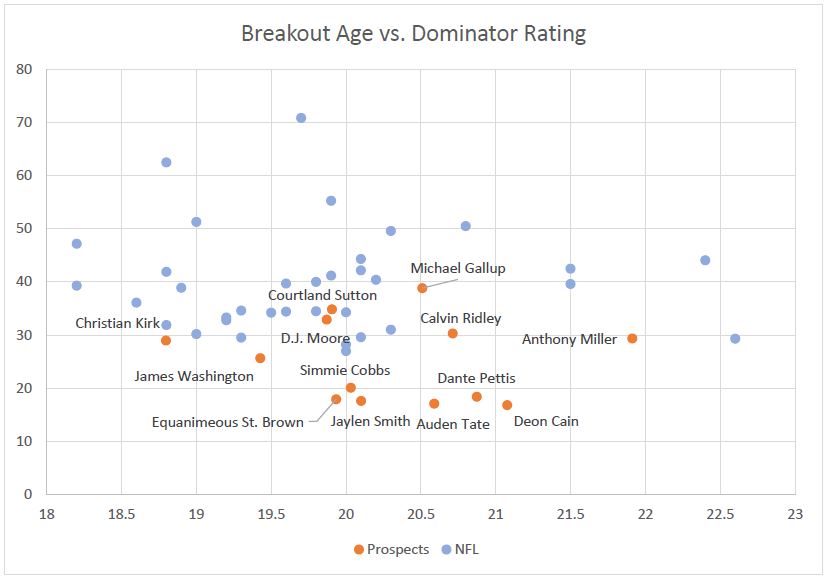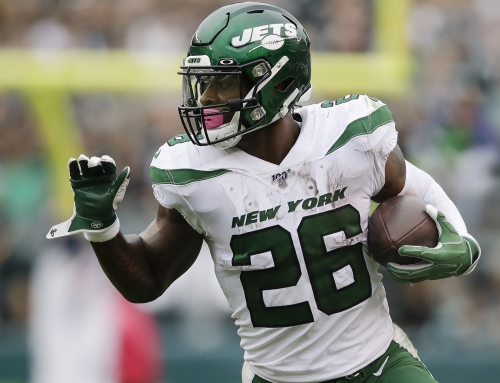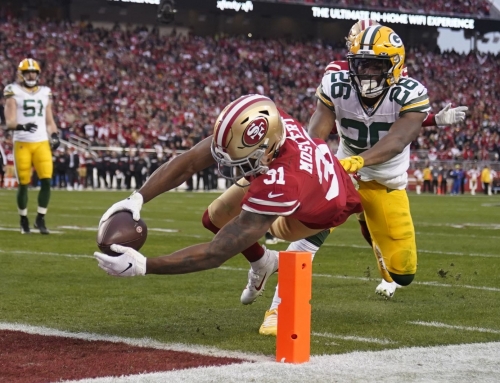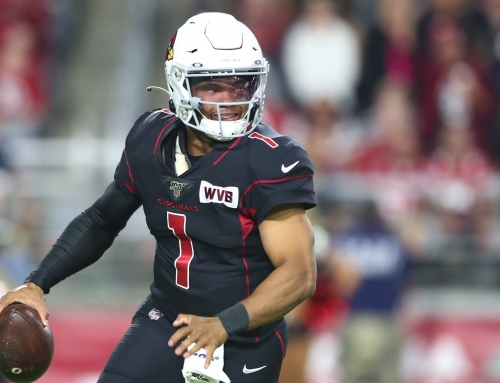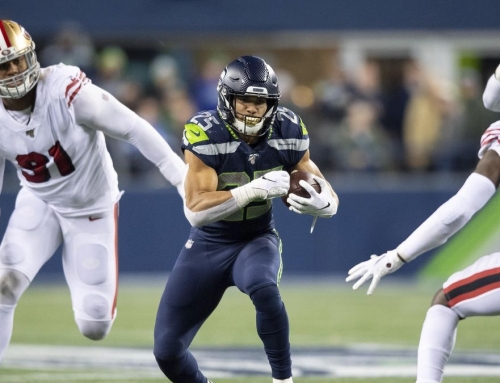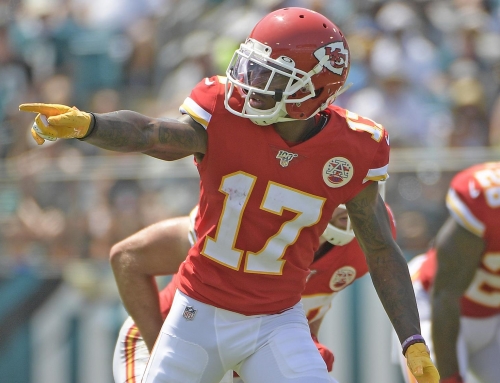One of the keys to any dynasty offseason is gaining an advantage in the rookie draft. As the draft gets closer and closer, we as dynasty owners will be able to obtain more and more information to help us evaluate incoming prospects and get a sense for their probability of success in the NFL, and thus our fantasy teams. There are many methods of prospect evaluation, and while some hold more importance than others, they are each a valuable tool to aid in the process. One quick and easy method to get a baseline feel for a position group is to look at simple metrics compared to players who have found success in the NFL. With the help of some popular metrics provided by playerprofiler.com, we can see how the incoming class of WRs stacks up against a typical fantasy-useful WR.
First, we need to understand the four metrics that will be referenced below. These are by no means the best or only values owners should be evaluating, but it’s a decent starting point.
Dominator Rating: Simply put, this is how big a part of his team’s offense the prospect is while at school. It’s the ratio of the total number of receiving yards and scores accounted for by the prospect versus the total number of receiving yards and scores accounted for by the team. This can be a more useful way to look at college production than raw stats because it puts the raw stats in the context of the offense being run by the program. For instance, while Demaryius Thomas’s 39-627-3 line as a sophomore doesn’t seem like anything to write home about, his dominator rating of nearly 50% indicates he was a huge piece of the offense that year. A note regarding this metric states that a value greater than 45% is considered extraordinary.
Breakout Age: A prospect’s breakout age is the age of the prospect during the first season he achieved a dominator rating of 20% or higher. This metric is useful for understanding how quickly a player’s natural gifts were able to translate onto the field. Being so heavily involved in an offense at a young age can be an indication of a player who is naturally at a higher talent level than those around them. A note regarding this metric says that a prospect with a breakout age under 19 is considered a phenom.
Speed Score: Much like dominator to raw stats, the speed score helps to contextualize a player’s 40-yard dash time by incorporating a player’s height and weight into the formula. This puts a premium on big, tall receivers who can run fast. Also known as the Al Davis score.
Yards per Reception (YPR): Easy enough – YPR is simply the total number of yards divided by the number of catches. Using this in conjunction with raw statistics can help get a feel for how much of a prospect’s production was big-play dependent. A note regarding this metric states that the highest value for a single season is used unless that value comes in a season before the player’s last season in school, in which case an average of those two seasons is used instead.
Now that there is a basic understanding of what’s being charted, below are several graphs showing where the incoming receiving prospects plot amongst the most fantasy-relevant WRs of the past few years. Below each graph are a few observations, but there are certainly more to make.
Breakout Age vs. Dominator Rating
One of my favorite plots. This is a very simple and quick method to show players who broke out at a young age (talent) and were able to put up big numbers throughout their collegiate careers (production).
- The only phenom in this class (that’s been plotted) is Christian Kirk. Kirk has seemingly flown a bit under the radar after a massive freshman season, but his production hasn’t dipped off all that much and his dominator rating has remained relatively constant.
- The top three WRs (Calvin Ridley, Courtland Sutton, and James Washington) all fall within a comparable range to the standard. No one particularly stands out as better or worse, but it’s a good confirmation to see.
- There’s a pretty clear delineation between prospects who match up well with the standard and those that don’t. Aside from the four already mentioned, the others who seem to fit this profile are D.J. Moore, Michael Gallup, and Anthony Miller.
Breakout Age vs. Speed Score

One way of identifying natural talent of a player. Being an exceptional athlete is only one piece of the puzzle and while having that trait can assist in masking other flaws, lacking it is certainly no death sentence for NFL production. Just look at the wide distribution of points on the chart. Obviously, there are no official 40 times or height and weight measurements at this time, so the numbers were taken from school sites and projected times for now.
- Again, Christian Kirk shows well in this plot as he and James Washington are the closest ones to the cluster of phenom athletes in the upper left like Amari Cooper, DeAndre Hopkins, Stefon Diggs, and Dez Bryant.
- While no one comes close to touching Calvin Johnson’s ridiculous speed score nearing 140, or Julio Jones and Demaryius Thomas at 125 for that matter, Courtland Sutton and Jaylen Smith project for above average values around 110.
YPR vs. Speed Score
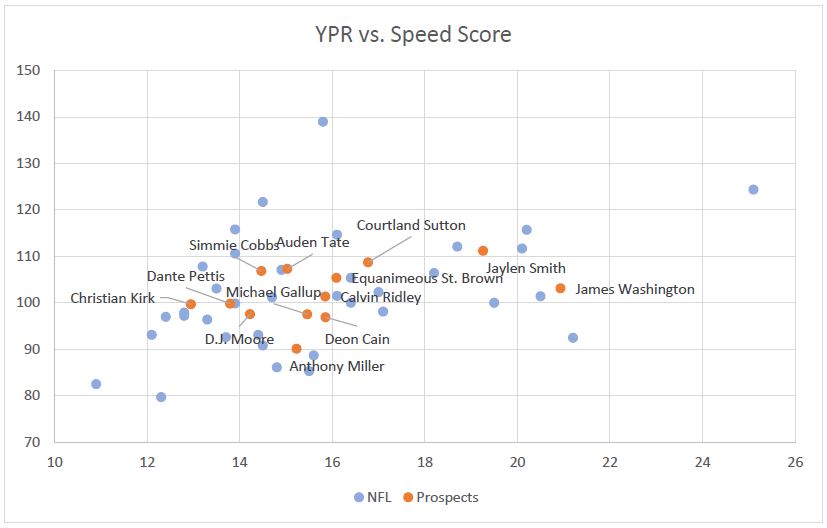
A way to get a basic feel for what type of receiver the prospect is. Big and/or fast downfield threats (e.g., Mike Evans, Mike Wallace, or Odell Beckham) will be to the top right while smaller and/or slower possession guys (e.g., Michael Crabtree, Jarvis Landry, or Doug Baldwin) will be bottom left.
- No prospect here stands out as a major outlier (e.g., Antonio Brown and Jamison Crowder). Instead, we can look at this as a tool to relate the prospects to similar successful NFL players to get an idea of how their game may or may not translate at the next level.
- Anthony Miller and D.J. Moore slot nicely with guys like Doug Baldwin, Cooper Kupp, and Emmanuel Sanders. They each have a YPR somewhere around 15 despite the below average speed score, showing one potential path for NFL success as secondary, or developing into primary, possession receivers with decent speed.
- The other two players on this side of the spectrum are Christian Kirk and Dante Pettis, who slot in with a similar group (James Jones, Michael Crabtree, and Jeremy Maclin). While each of these NFL players have shown success at the next level, it’s not necessarily through utilizing the type of game Kirk and Pettis are best known for – dynamic, big play receivers. This realization alone shouldn’t cause you to shy away from these two playmakers, but it is a potential flag to keep in mind moving deeper into the evaluation process.
A few disclaimers: as I stated in the beginning, metrics are by no means the only tool owners should use during this process. Watching film and highlights, sifting through reports, and paying attention to the NFL’s draft process are all important as well. Watching a prospect on film can help support what you see in the numbers and vice versa. Combining the two processes can also help you look past numbers or look past great plays on film to identify flags, strengths, and other traits that aren’t necessarily revealed in either of the processes. These four metrics are only scratching the surface of all the great data already out there to delve into.
Lastly, the observations made here are only one person’s interpretation and if there’s one thing worth noting about charts and data, it’s that everyone can see and interpret them a little bit differently.



